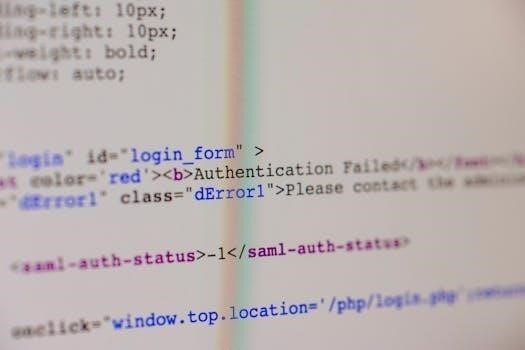IT-205 Instructions⁚ A Comprehensive Guide
Navigating Form IT-205 can be complex․ This guide offers a comprehensive overview to assist fiduciaries in New York State․ It provides clarity on filing requirements, income allocations, and modifications to federal taxable income․ Proper adherence ensures accurate tax filings and compliance with state regulations, ultimately benefiting both the fiduciary and beneficiaries․
Overview of Form IT-205
Form IT-205, the Fiduciary Income Tax Return, serves as the cornerstone for reporting income tax obligations for New York State resident and nonresident estates and trusts․ This comprehensive form mandates fiduciaries to meticulously detail income, deductions, and modifications to federal taxable income, ensuring accurate calculation of New York State income tax liabilities․
Fiduciaries must accurately complete all relevant schedules, including those pertaining to income allocation, modifications, and payments․ Furthermore, understanding the interplay between federal tax laws and New York State tax regulations is crucial for compliance․ Form IT-205 also encompasses provisions for reporting New York City and Yonkers taxes, where applicable, adding another layer of complexity for fiduciaries to navigate․
Accurate completion hinges on a thorough understanding of the instructions provided in Form IT-205-I, which serves as a roadmap for fiduciaries․ Failing to adhere to these instructions can lead to errors, potentially resulting in penalties and interest charges․ Therefore, careful attention to detail and diligent record-keeping are paramount when preparing and submitting Form IT-205․

Moreover, fiduciaries should stay abreast of any updates or amendments to the New York State Tax Law, as these changes may impact their reporting obligations․ Staying informed ensures compliance and minimizes the risk of non-compliance․
Who Must File Form IT-205?
Determining the filing requirement for Form IT-205 is crucial for fiduciaries overseeing estates and trusts in New York State․ Generally, the fiduciary of a New York State resident estate or trust must file Form IT-205 if the entity meets certain criteria․ These criteria typically revolve around the presence of federal filing requirements, the existence of New York source income, or liability for separate tax on lump-sum distributions․
Specifically, if the estate or trust is required to file a federal income tax return, it is likely obligated to file Form IT-205․ Furthermore, if the estate or trust possesses income derived from New York State sources, regardless of whether a federal return is required, filing Form IT-205 becomes necessary․ This includes income from real property located in New York, business activities conducted within the state, or other sources attributable to New York․
In addition, estates and trusts subject to a separate tax on lump-sum distributions are also mandated to file Form IT-205․ It is important to note that the filing requirements may differ for resident and nonresident estates and trusts, necessitating careful consideration of the entity’s residency status․ Nonresident estates and trusts are generally required to file Form IT-205 only if they have income derived from New York State sources and meet certain income thresholds․
New York State Resident Estates and Trusts
For New York State resident estates and trusts, the filing of Form IT-205 is generally required if the estate or trust meets certain conditions․ A resident estate is typically defined as the estate of a deceased individual who was a resident of New York State at the time of their death․ A resident trust, on the other hand, is often defined as a trust created by a New York State resident or a trust that is administered in New York State․
These resident entities must file Form IT-205 if they are required to file a federal income tax return, such as Form 1041, U․S․ Income Tax Return for Estates and Trusts․ Additionally, filing is necessary if the resident estate or trust has any income derived from New York State sources, regardless of whether a federal return is required․
This includes income from real property located within New York, business activities conducted in the state, or any other income attributable to New York sources․ Furthermore, if the resident estate or trust is subject to a separate tax on lump-sum distributions, it must also file Form IT-205․ Fiduciaries of resident estates and trusts should carefully review the instructions for Form IT-205 to ensure compliance with all applicable filing requirements․

New York Nonresident Estates and Trusts
New York nonresident estates and trusts also have specific requirements regarding Form IT-205․ A nonresident estate or trust is one that does not meet the criteria to be considered a New York State resident entity․ These entities are required to file Form IT-205 if they have income derived from New York State sources and their New York adjusted gross income (NYAGI) exceeds a certain threshold․
New York source income for nonresident estates and trusts includes income from real property located in New York, income from a business, trade, or profession carried on within New York, and income from intangible personal property employed in a trade, business, or profession within New York․ Furthermore, gains from the sale of real or tangible personal property located in New York are also considered New York source income․
The fiduciary of a nonresident estate or trust must determine the portion of the entity’s income that is derived from New York sources․ This determination is crucial for accurately completing Form IT-205 and calculating the New York State tax liability․ Careful attention should be paid to the instructions provided by the New York State Department of Taxation and Finance to ensure proper reporting and compliance․
Understanding New York Source Income
Determining New York source income is a critical step when completing Form IT-205, particularly for nonresident estates and trusts․ New York source income generally includes income derived from activities or property located within New York State․ This can encompass various types of income, each requiring careful consideration for accurate reporting․
One primary category is income from real property situated in New York․ This includes rental income, gains from the sale of property, and other income directly related to the real estate․ Additionally, income from a business, trade, or profession carried on within New York is considered New York source income, irrespective of the entity’s residency․
Furthermore, income from intangible personal property, such as stocks or bonds, is considered New York source income if the property is employed in a trade, business, or profession carried on within New York․ It’s essential to identify and accurately allocate all income streams connected to New York activities to ensure compliance with state tax regulations and avoid potential penalties․

Key Schedules and Forms Related to IT-205
Form IT-205, the Fiduciary Income Tax Return, often requires the completion of several supporting schedules and forms to accurately report income, deductions, and tax liabilities․ Understanding these related documents is crucial for compliant filing․ One essential schedule is Form IT-205-A, Fiduciary Allocation, used to allocate income and modifications between resident and nonresident beneficiaries․
Another key form is IT-205-V, the Payment Voucher, which accompanies any tax payments made with the return․ For estates and trusts with nonresident beneficiaries, Schedule A is important for calculating the New York source income․ Furthermore, Form IT-225 may be needed for New York State modifications, detailing additions and subtractions from federal taxable income․
Additionally, depending on the specific circumstances, other forms such as IT-370-PF for extension requests or schedules related to lump-sum distributions might be necessary․ Consulting the instructions for each form and schedule is vital to ensure accurate completion and avoid processing delays or penalties․ These documents collectively provide a comprehensive view of the estate or trust’s financial activities․
IT-205-I⁚ Instructions for Form IT-205

The IT-205-I document serves as the primary guide for fiduciaries completing Form IT-205, the New York State Fiduciary Income Tax Return․ This instruction booklet provides detailed explanations of each line item on the form, clarifies eligibility requirements, and outlines specific procedures for calculating taxable income and deductions․ It addresses who must file the return, including resident estates, trusts, and nonresident entities with New York source income․
Furthermore, IT-205-I offers guidance on determining New York adjusted gross income (NYAGI) and navigating the complexities of modifications to federal taxable income․ It includes schedules and worksheets to assist in accurately calculating the tax liability․ The instructions also cover topics such as estimated tax payments, extensions, and amended returns․ Moreover, it explains the documentation required to support the claims made on Form IT-205․
Fiduciaries should carefully review IT-205-I before preparing the return to ensure compliance with New York State tax laws․ Understanding the instructions is essential for avoiding errors, penalties, and delays in processing the tax return․ The document is regularly updated, so using the version for the relevant tax year is crucial․
IT-205-V⁚ Payment Voucher Instructions
Form IT-205-V, the Payment Voucher for Fiduciary Income Tax Returns, is a critical component for remitting tax payments to New York State․ The instructions for this voucher detail how to properly complete and submit payments associated with Form IT-205․ It specifies who must use the voucher, which includes those making estimated tax payments or remitting balances due with their filed return․
The IT-205-V instructions outline the required information, such as the estate or trust’s employer identification number (EIN), the tax year, and the amount of payment․ It explains where to mail the voucher and payment, providing specific addresses for different payment types, including estimated tax and balance due payments․ The instructions also clarify the acceptable payment methods, like check or money order, and emphasizes that cash payments are not accepted․
For those who e-file Form IT-205, the instructions address how to submit payments separately using IT-205-V․ It highlights the importance of using the correct voucher for the corresponding tax year to ensure proper credit of payments․ Additionally, the instructions advise taxpayers to retain a copy of the voucher and payment for their records․ Following these instructions carefully helps ensure timely and accurate payment processing, preventing potential penalties or interest charges․
IT-205-A⁚ Fiduciary Allocation Instructions
Form IT-205-A and its accompanying instructions are essential for fiduciaries needing to allocate income among beneficiaries, particularly in situations involving nonresident beneficiaries or complex trust structures․ The IT-205-A instructions provide detailed guidance on how to determine the correct allocation percentages and amounts of income that should be reported by each beneficiary on their individual income tax returns․
These instructions cover various scenarios, including resident estates or trusts with nonresident beneficiaries, and situations where income is derived from sources both within and outside of New York State․ They explain how to calculate the allocation percentage based on factors such as the location of assets, the residency of beneficiaries, and the terms of the trust agreement․
The IT-205-A instructions also address specific items of income and deduction, such as interest, dividends, rents, royalties, and capital gains, and how these items should be allocated among beneficiaries․ Furthermore, they provide examples and worksheets to assist fiduciaries in accurately completing the form and determining the proper allocation amounts․ Understanding and following these instructions is crucial for ensuring that beneficiaries correctly report their share of the estate or trust’s income and avoid potential tax issues․
Modifications to Federal Taxable Income
When preparing Form IT-205, fiduciaries must carefully consider modifications to federal taxable income to arrive at the correct New York taxable income for the estate or trust․ These modifications involve adding back certain items that were deducted for federal purposes but are taxable in New York, and subtracting items that were included in federal taxable income but are exempt from New York tax․
Common add-back modifications include state and local income taxes deducted on the federal return, as well as certain depreciation adjustments․ Subtraction modifications may include items such as interest from U;S․ government obligations, which is exempt from state tax․ The IT-205 instructions provide a comprehensive list of these modifications and detailed guidance on how to calculate the correct amounts․
It’s crucial to review the instructions carefully, as the specific modifications required can vary depending on the nature of the income and deductions of the estate or trust․ Furthermore, documentation should be maintained to support any modifications made․ Accurate reporting of these modifications is essential for ensuring compliance with New York State tax law and avoiding potential penalties or interest charges․
Filing and Payment Procedures
Proper filing and payment procedures are critical for fiduciaries submitting Form IT-205․ The form, along with any required schedules and documentation, must be filed with the New York State Tax Department by the due date, which generally aligns with the federal income tax return due date․ Extensions may be available, but specific forms, such as IT-370-PF, must be filed to request an extension of time to file․
Payments can be made electronically or by mail․ Electronic payments are generally preferred and can be submitted through the Tax Department’s website․ If paying by mail, use Form IT-205-V, the Payment Voucher, and send the payment to the address specified on the voucher․ It is essential to include the estate or trust’s employer identification number (EIN) on all payments to ensure proper crediting․
When e-filing Form IT-205, ensure that all required forms, including Form IT-205-A, are included․ Failure to include required forms may result in rejection of the return․ Fiduciaries should maintain records of all filings and payments for at least three years․ Following these procedures carefully will ensure timely and accurate filing and payment, minimizing the risk of penalties or interest․

